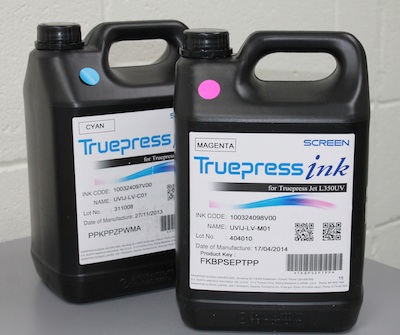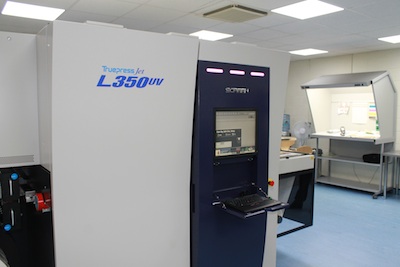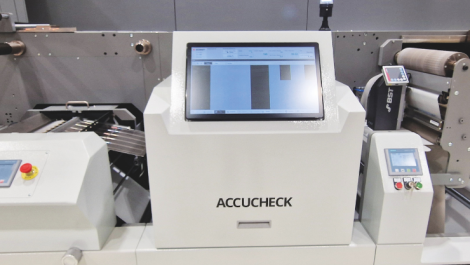The new demo room at Dantex with the Screen press
Standing proud in a new dedicated demo room, the Screen Truepress Jet L350UV digital label press, which is due to be installed at a second UK customer in the next month, was the centre of attention during an open house held by Dantex at its Bradford headquarters in September. The Digital Labels & Packaging team went along to the event.
Having made the decision to move into the inkjet market by taking on the distribution rights in Austria, Benelux, France, Germany, Ireland, Italy, Poland, Switzerland, Turkey and the UK of the Screen Truepress Jet L350UV, Dantex Graphics Limited opened its doors for two days in September to show visitors the capabilities of the new label press.
Press on show
The digital inkjet label press is situated in a climate-controlled room at Dantex, but we were reassured that it is just as happy to fit into any established pressroom with no changes made or special requirements needed. It is a fairly compact machine, which has the inkwell unit and power system, including UV extraction, neatly tucked away at the back.
Printing on webs of 100 mm to 350 mm in width (actual maximum print width is 322 mm), coming off rolls of up to 750 mm in diameter, the press is controlled through an intuitive touchscreen panel with self-explanatory icons for each function. At the start of the day, a quick 10 minute maintenance cycle is performed. This fires ink through each nozzle to check for blockages, while a wiper blade cleans any residues off the heads. A short clean is also required at the end of the day.
Simon Cosh, Dantex technical sales representative, showed us the press. He said, ‘One of the many strengths of the machine is that the touchscreen operation makes it so easy to use. It is very operator friendly. With just a few presses on the screen and we can be running thousands and thousands of labels.’
Advantages aplenty
The press is described as ‘high performance’ running at a speed of 50 m/min, which translates into 16.1 square metres of print per minute. The ink station can be refilled while the press is running and the proprietary ink is supplied in 5 litre containers. Substrates do not need any coating or priming and can range in thickness from 0.09 mm to 0.35 mm. This means that printers can use conventional substrates that may already be in stock and eliminates the need for a separate stock of digital media.
Mr Cosh explained, ‘One of the big advantages of the press is that it can run on standard substrates. Another is that it is fitted with Kyocera printheads, which are the highest quality native printheads on the market. The heads are 108 mm wide, which is much wider than some of our competitors, and therefore we only need three heads per colour. Today we are running CMYK plus white so five colours but only a total of 15 printheads. Furthermore, we print down to a 3 picolitre dot which means that we can put a much thinner layer of ink down onto the substrate, reducing the cost per label. It also makes it highly efficient when it comes to the UV element.’

Screen’s proprietary ink for the Truepress offers a wider gamut
The print resolution from the greyscale piezo Kyocera heads is 600 x 600 dpi and each head contains 2656 nozzles delivering 30,000 drops per second. Screen’s own Truepress inks have been formulated to provide coverage of a wider gamut than normal CMYK inks and the opaque white is laid down in one pass. UV LEDs pin the ink once after the white and once after the CMYK.
With on the fly spot colour adjustment, colours can be matched either by eye or using a spectrophotometer to match up to 80% of Pantones. Featuring a proprietary four step droplet size, the press can produce photo-level images when needed.
Options include web cleaner, Corona treater, and mark sensors for re-registration of pre-printed webs. Although the press can run without a web cleaner, it is recommended to have one fitted to prolong the life of the printheads.
Joining the party
Distributor of letterpress and flexographic photopolymer plate materials for over 40 years, Dantex first ventured into digital label printing a few years ago with the Dantex 1290, a small roll-fed label printer, designed for short to mid-run production. With the Truepress, the company has taken a decisive step into the industrial digital inkjet arena, and we were naturally curious to hear why this decision was made.
Andrew Abbott, general manager, said, ‘We saw the future of the printing industry moving towards digital – in the last three to four years it has become more prominent in our customer base. We actually looked at digital as a bit of a threat at first because our traditional market is analogue and CtP plates. We were concerned that it was going to interrupt our flow of business, but when we spoke to our customers and realised that they see digital as a complement to conventional printing and not a replacement, we decided to join the party.’
Dantex has a long association with Screen having previously sold its imagesetters, amongst others, and there is a further synergy in that both companies’ products originate in Japan. Mr Abbott said, ‘We also knew from experience that the people within Screen were good people, and that they had a good technology, but didn’t know the label market as well as we did. So when we sat at the table, it was a good marriage.’
He continued, ‘We fit into the market very well because we have 40 years’ experience in the label sector. We know the label industry inside out, so the fit is that we know what the customers want, we know what their requirements are, but we are coming at it from the other side and have found a machine that fit those requirements.’
Second installation
The first installation of the Truepress Jet L350UV was at Springfield Solutions, which bought the press earlier this year to boost productivity and enable the development of new label applications.
A second UK installation is currently being finalised with the name of the customer still under wraps.
We asked Mr Abbott why this company decided to invest in the Truepress. He said, ‘The customer did very good due diligence and tried every single press on the market, narrowing the search down to three companies, including ourselves. We were actually the latecomer and the customer had already decided who they were going to go choose until we produced print samples which were much better than anything else they had seen. The only stumbling block at the time was the missing white, but we then produced the white and that fitted the bill too. We then went to a head to head trial and basically we came out on top.’
Also on site at the open day were MIS and workflow specialist, Time Harvest, and pre-press solutions provider, Graphic Republik.






